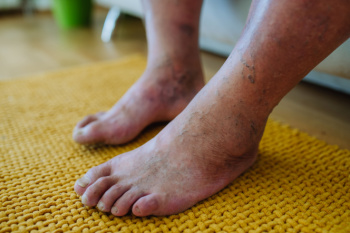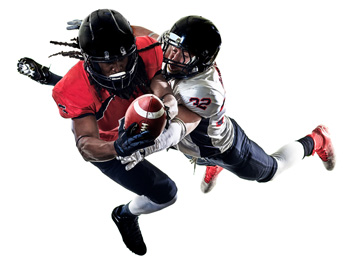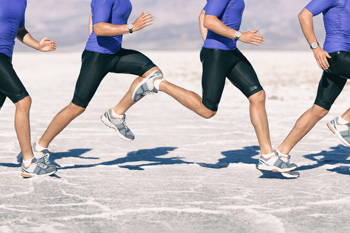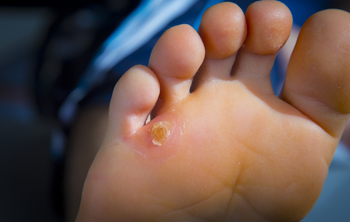3320 North Buffalo Drive
Suite 107
Las Vegas, NV 89129

Diabetes is a chronic condition that affects the body's ability to regulate blood sugar levels, often leading to complications in the feet. High blood sugar can damage blood vessels and nerves, reducing circulation and sensation in the feet. This makes individuals with diabetes more susceptible to foot injuries and infections, as they may not feel wounds or pressure sores developing. If not properly treated, even minor foot injuries can lead to serious complications, such as ulcers, infections, or in severe cases, amputation. Proper diabetic foot care includes regular inspection of the feet for cuts, blisters, or sores, keeping the feet clean and dry, and wearing properly fitted shoes to avoid friction. Preventive measures like controlling blood sugar levels, regular foot check-ups with a podiatrist, and proper foot hygiene are imperative to avoiding serious complications and maintaining overall foot health. If you have diabetes and notice a foot wound, it is essential to see a podiatrist promptly to prevent an infection.
Diabetic foot care is important in preventing foot ailments such as ulcers. If you are suffering from diabetes or have any other concerns about your feet, contact one of our podiatrists from Summerlin Foot & Ankle. Our doctors can provide the care you need to keep you pain-free and on your feet.
Diabetic Foot Care
Diabetes affects millions of people every year. The condition can damage blood vessels in many parts of the body, especially the feet. Because of this, taking care of your feet is essential if you have diabetes, and having a podiatrist help monitor your foot health is highly recommended.
The Importance of Caring for Your Feet
Patients with diabetes should have their doctor monitor their blood levels, as blood sugar levels play such a huge role in diabetic care. Monitoring these levels on a regular basis is highly advised.
It is always best to inform your healthcare professional of any concerns you may have regarding your feet, especially for diabetic patients. Early treatment and routine foot examinations are keys to maintaining proper health, especially because severe complications can arise if proper treatment is not applied.
If you have any questions please feel free to contact our office located in Las Vegas, NV . We offer the newest diagnostic and treatment technologies for all your foot and ankle needs.

Football players are particularly prone to ankle and foot injuries due to the sport’s high-impact nature and frequent lateral movements. Common injuries include sprains, where ligaments are stretched or torn, often from sudden changes in direction or contact. Fractures, such as those of the metatarsals or the ankle bones, occur from direct impacts or severe twists. Tendon injuries, like Achilles tendinitis, also pose a risk due to repetitive strain. Symptoms of these injuries typically include pain, swelling, and difficulty moving the affected area. Prevention strategies include wearing appropriate footwear with good support, incorporating strengthening exercises into training, and practicing proper techniques to reduce the risk of injury. If you have endured a foot or ankle injury while playing football, it is suggested that you visit a podiatrist for treatment, and offer you effective injury prevention techniques.
Sports related foot and ankle injuries require proper treatment before players can go back to their regular routines. For more information, contact one of our podiatrists of Summerlin Foot & Ankle. Our doctors can provide the care you need to keep you pain-free and on your feet.
Sports Related Foot and Ankle Injuries
Foot and ankle injuries are a common occurrence when it comes to athletes of any sport. While many athletes dismiss the initial aches and pains, the truth is that ignoring potential foot and ankle injuries can lead to serious problems. As athletes continue to place pressure and strain the area further, a mild injury can turn into something as serious as a rupture and may lead to a permanent disability. There are many factors that contribute to sports related foot and ankle injuries, which include failure to warm up properly, not providing support or wearing bad footwear. Common injuries and conditions athletes face, including:
Sports related injuries are commonly treated using the RICE method. This includes rest, applying ice to the injured area, compression and elevating the ankle. More serious sprains and injuries may require surgery, which could include arthroscopic and reconstructive surgery. Rehabilitation and therapy may also be required in order to get any recovering athlete to become fully functional again. Any unusual aches and pains an athlete sustains must be evaluated by a licensed, reputable medical professional.
If you have any questions please feel free to contact our office located in Las Vegas, NV . We offer the newest diagnostic and treatment technologies for all your foot and ankle needs.
 A biomechanical assessment of the foot and ankle is a detailed evaluation conducted to understand the movement patterns and structural alignment of these areas. This assessment involves examining how the foot and ankle move during various activities, such as walking or running and identifying any abnormalities or dysfunctions. The primary purpose of a biomechanical assessment is to diagnose issues that may cause pain, discomfort, or impaired function. Common conditions identified through this process can include flat feet, overpronation, supination, and alignment issues affecting the knees, hips, and lower back. The assessment typically includes visual and physical examinations, gait analysis, and sometimes advanced imaging techniques. Conducting a biomechanical assessment is important for developing personalized treatment plans. It helps in prescribing appropriate orthotics, footwear, and exercises to correct identified problems. This evaluation is essential for athletes, individuals with chronic pain, and those recovering from injuries. If you have chronic foot or ankle pain, it is suggested that you visit a podiatrist for a biomechanical assessment and treatment based on results.
A biomechanical assessment of the foot and ankle is a detailed evaluation conducted to understand the movement patterns and structural alignment of these areas. This assessment involves examining how the foot and ankle move during various activities, such as walking or running and identifying any abnormalities or dysfunctions. The primary purpose of a biomechanical assessment is to diagnose issues that may cause pain, discomfort, or impaired function. Common conditions identified through this process can include flat feet, overpronation, supination, and alignment issues affecting the knees, hips, and lower back. The assessment typically includes visual and physical examinations, gait analysis, and sometimes advanced imaging techniques. Conducting a biomechanical assessment is important for developing personalized treatment plans. It helps in prescribing appropriate orthotics, footwear, and exercises to correct identified problems. This evaluation is essential for athletes, individuals with chronic pain, and those recovering from injuries. If you have chronic foot or ankle pain, it is suggested that you visit a podiatrist for a biomechanical assessment and treatment based on results.
If you have any concerns about your feet, contact one of our podiatrists from Summerlin Foot & Ankle. Our doctors can provide the care you need to keep you pain-free and on your feet.
Biomechanics in Podiatry
Podiatric biomechanics is a particular sector of specialty podiatry with licensed practitioners who are trained to diagnose and treat conditions affecting the foot, ankle and lower leg. Biomechanics deals with the forces that act against the body, causing an interference with the biological structures. It focuses on the movement of the ankle, the foot and the forces that interact with them.
A History of Biomechanics
Modern technological improvements are based on past theories and therapeutic processes that provide a better understanding of podiatric concepts for biomechanics. Computers can provide accurate information about the forces and patterns of the feet and lower legs.
Understanding biomechanics of the feet can help improve and eliminate pain, stopping further stress to the foot.
If you have any questions please feel free to contact our office located in Las Vegas, NV . We offer the newest diagnostic and treatment technologies for all your foot and ankle needs.

Corns on the feet can stem from various factors, with age being one of them. As people grow older, their feet undergo physical and biomechanical changes. These can affect how they function and alter the way you walk, potentially leading to corns. WearingiIll-fitting socks can also contribute to corns on the feet. Too large socks may slip and cause friction, while tight socks can irritate the skin. Shoes that do not fit properly, especially high-heeled or narrow shoes, whether too big or too small, can cause friction and pressure, causing a corn to develop. Obesity can alter your gait and weight distribution, often resulting in foot deformities like flat feet, which in turn make corns more likely to develop. Hammertoes or bunions exert unusual pressure on parts of the foot, promoting corn formation. A podiatrist can treat a foot corn by trimming the skin with a sharp tool to remove the outer layers of the corn. Another option is corn reduction, which calls for cutting away excess bone, repositioning larger bones, or attaching joints. In some cases, a cortisone injection directly into the corn can provide significant relief. If you are suffering from the pain of corns on the feet, it is suggested that you schedule an appointment with a podiatrist.
If you have any concerns regarding your feet and ankles, contact one of our podiatrists of Summerlin Foot & Ankle. Our doctors will treat your foot and ankle needs.
Corns: What Are They? and How Do You Get Rid of Them?
Corns can be described as areas of the skin that have thickened to the point of becoming painful or irritating. They are often layers and layers of the skin that have become dry and rough, and are normally smaller than calluses.
Ways to Prevent Corns
There are many ways to get rid of painful corns such as wearing:
Treating Corns
Treatment of corns involves removing the dead skin that has built up in the specific area of the foot. Consult with Our doctors to determine the best treatment option for your case of corns.
If you have any questions please feel free to contact our office located in Las Vegas, NV . We offer the newest diagnostic and treatment technologies for all your foot and ankle needs.